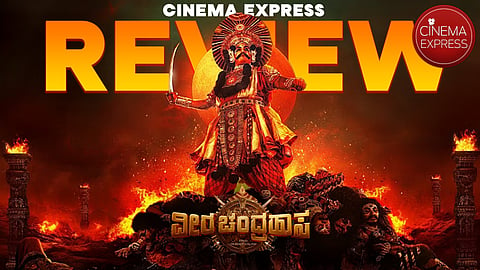Veera Chandrahasa Movie Review: Ravi Basrur triumphs daring to blend cinema and Yakshagana
Veera Chandrahasa(3 / 5)
When cinema dares to don the crown of Yakshagana, the film shouldn't just entertain but should perform as an entity. Known for his thunderous background scores in mainstream actioners like KGF and Salaar, to name a few, Ravi Basrur, who occasionally switches to direction, now steps into the open-air theatre of Karnataka’s soul and attempts something audacious with Veera Chandrahasa. Translating the living, breathing pulse of Yakshagana on screen, he doesn’t just helm; he channels.
Standing out from a regular period film embellished with grandeur, Veera Chandrahasa is a cultural plunge into a traditional art form well-balanced with its reverberating music and lyrical richness; stylistically made while also true to its spiritual roots. The film revisits the myth of Chandrahasa, an orphaned boy destined for the throne — a tale known to many through Yakshagana lore and even through the classic 1965 film Chandrahasa, starring Dr. Rajkumar. This retelling of Ravi Basrur doesn't milk on nostalgia but attempts to revive this classic.
Director: Ravi Basrur
Cast: Shithil Shetty, Prasanna Shettigar, Nagashree GS, Shivarajkumar, and Uday Kadabal
From the very first frame, the film proclaims its commitment. Every line is performed, not just mouthed. The conversations echo in the elongated metre of Yakshagana; the costumes — vivid, exaggerated, packed with symbolism — never stray from the roots. It is as if the entire film was transported from a Bayalata stage and dropped into a digital frame.
The plot is straightforward but is also layered. A prophecy foretells Chandrahasa’s rise — the boy with six fingers. Threatened by the oracle, Dushtabuddhi, a venomous minister, sets out to kill the child. But fate has destined Chandrahasa for something big. Chandrahasa survives and returns — unknowingly — to the land that once conspired against him. What follows is not merely a revenge arc, but a tug-of-war between destiny and deceit, played out with rhythm, rhyme, and theatrical flair.
The director reimagines Yakshagana with care and courage. The live narration might be missing, but its essence lingers in the background score. Instead of mimed fights and symbolic gestures, we get real horse chases, collision of weapons, and battle scenes that feel cinematic without losing their folk sheen. The rhythm is retained. The structure is tweaked without diluting the soul.
The performances are rooted and radiant. Many actors are actual Yakshagana artists — and it shows. Shithil Shetty plays Chandrahasa with admirable restraint, but it’s Prasanna Shettigar Mandarthi who brings fire to the frame. As Dushtabuddhi, he’s all swagger and slyness — a villain you love to watch, hate, and admire. His smile carries mischief, and his words drop like curses wrapped in poetry.
Comic relief comes in the form of Uday Hegde Kadabala’s Madana. Some jokes land, others feel forced — but they serve as breathers between the dramatic highs. Shivarajkumar’s special appearance adds substance, while the figures of Dr. Rajkumar and Puneeth Rajkumar, appearing through CG, come as a tribute. Chandan Shetty, Garuda Ram, and Puneeth Rudranag helped make the film attractive with less to contribute to the narrative.
No Yakshagana-inspired work is complete without music — and here, Ravi Basrur does what he knows best: score. The background music is intense — sometimes grand, sometimes restrained — but always aligned with the tone. Traditional instruments are used wisely and sparingly, but powerfully. The poetic sequences — chanted rather than sung — add a ceremonial quality to the viewing experience.
Visually, the film walks a tightrope. The VFX and set design are not overly gaudy, but they bridge the theatrical with the cinematic. The palace corridors, battlefield smoke, and dream-like transitions felt like a painting in motion. And that works.
Still, the rhythm is different. It demands attention and asks viewers to tune into a slower, poetic frequency. If you’re unfamiliar with Yakshagana, it might test your patience at times. But once you give it time, the film finds its groove — and holds your attention.
There’s always a risk in marrying folk art with cinema. One is oral and improvised; the other is visualised and edited. Veera Chandrahasa doesn’t need to achieve a perfect fusion. What counts is the intention — and here, Ravi Basrur’s intent is clear: not to modernise Yakshagana, but to spotlight it. He brings a new cinematic grammar that honours an old, breathing form.
At its core, Veera Chandrahasa is a love letter to an art form that refuses to wane. And in an era of polished epics and formula storytelling, this film stands apart — raw, risk-taking, and reverent.
The idea that cinema can be a stage for heritage — this is a rare offering. It’s a celebration of the coastal Karnataka — the kind that demands we not just watch, but listen. Veera Chandrahasa doesn’t just tell a story. It sings it, chants it, performs it. And in doing so, it dares to dream differently.


